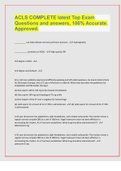Exam (elaborations)
ACLS COMPLETE latest Top Exam Questions and answers, 100% Accurate. Approved.
ACLS COMPLETE latest Top Exam Questions and answers, 100% Accurate. Approved. __________ can help indicate coronary perfusion pressure - -Capnography ___________ correlates w/ ROSC - -High quality CPR 2nd degree mobitz - - 2nd degree wenckebach - - 62 yr old man suddenly expereince...
[Show more]



